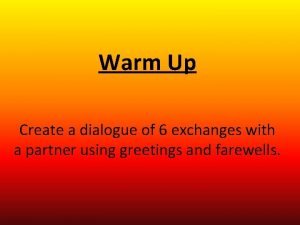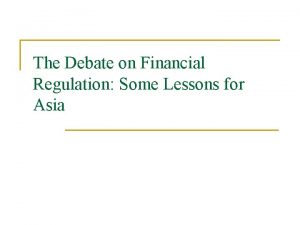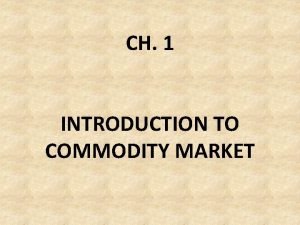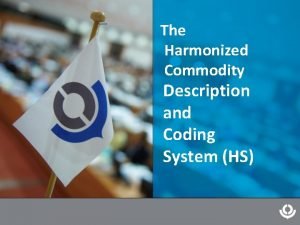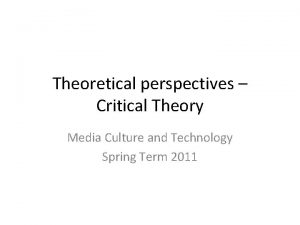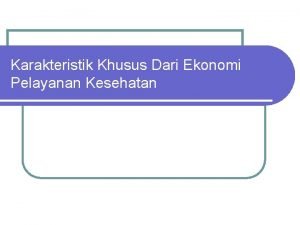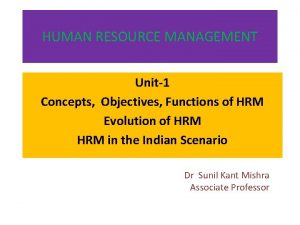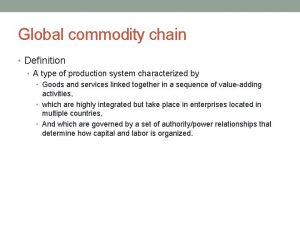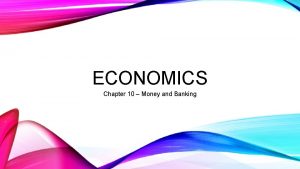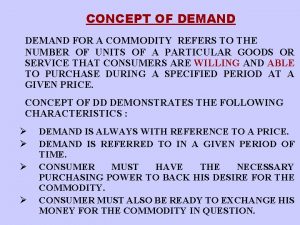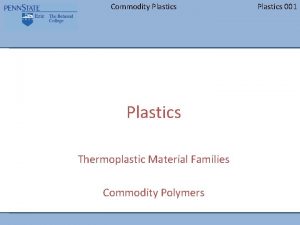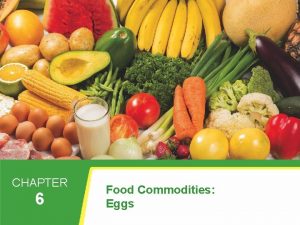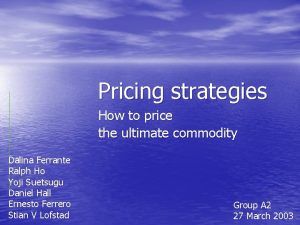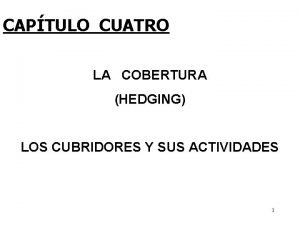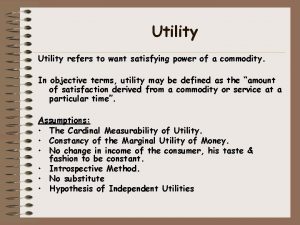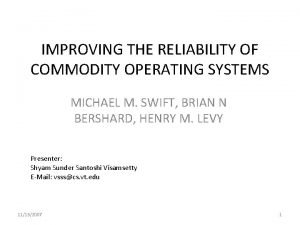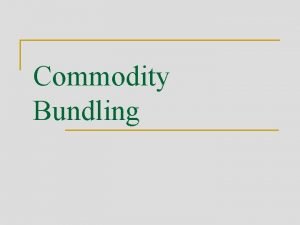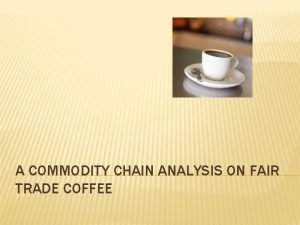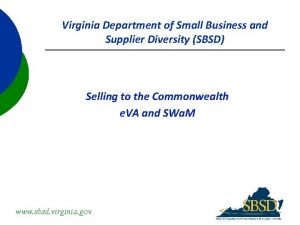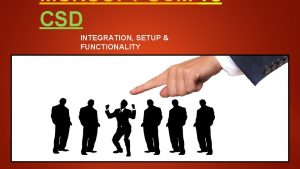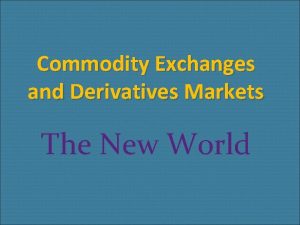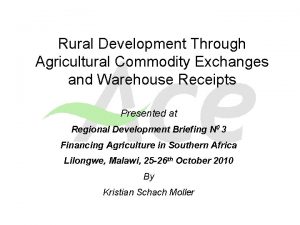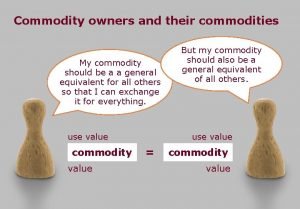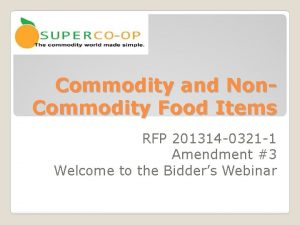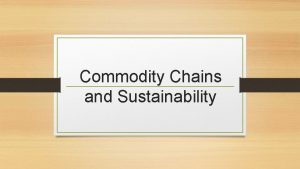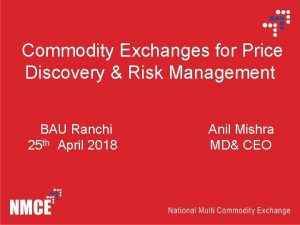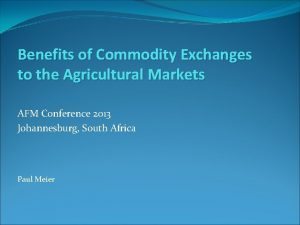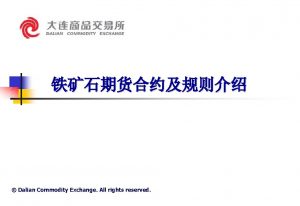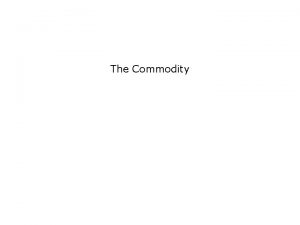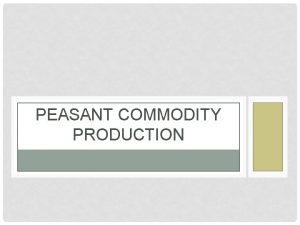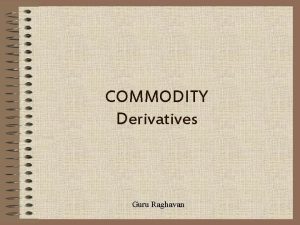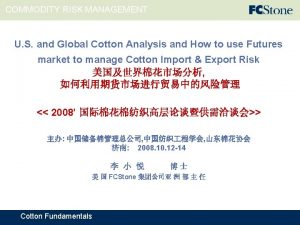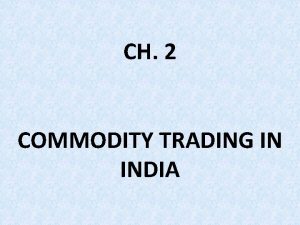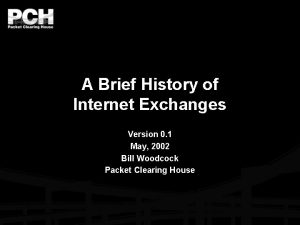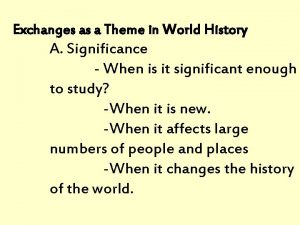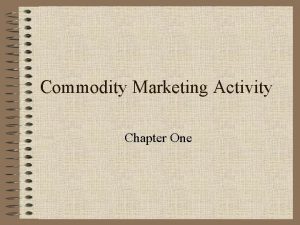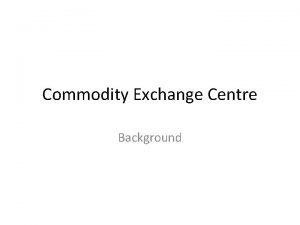Commodity Exchanges Introduction and History v v v




























- Slides: 28

Commodity Exchanges

Introduction and History v v v Commodity futures trading in India is not a new concept. India has a very rich tradition in commodity futures. Until late 60’s vibrant futures market in n Castor seed, mustard, linseed, sesame seed, coconut oil, Groundnut seed, turmeric, cotton, raw jute, Jute goods, wheat, rice, sugar, gold and silver etc.

Timeline v v v 1939: The Indian government bans futures trading because of 2 nd World War. 1952: Gov enacts Forward Contract (Regulation) Act, 1953: Sets up Forward Market Commission and starts futures trading in several commodities 1960: Again bans the commodity market due to price rigging 1960 onwards: Market goes underground. Post liberalization: Again commodity is back

Issues with Commodity Market in India v v Indian Commodity Market is basically fragmented and isolated. Spot trading in un-graded commodities in regional mandis and unorganized markets v Government procurement activity v MSP distorting market in favour of food grains

Coming of Age “Prices shall be fixed taking into account the investment, the quantity to be delivered, duty, interest, rent and other expenses” : Kautilya’s Arthashastra; {section-4. 2. 36}

Sequence of Events v v Organized futures market was evolved in India Ø Setting up of “Bombay Cotton Trade Association Ltd. ” in 1875. Ø Oilseeds for the first time, with the setting up of “Gujrati Vyapari Mandi” in 1900; later on re-constituted into “Seeds Trading Association Ltd”. Ø Raw Jute and Jute Goods began in Kolkata with the establishment of the Calcutta Hessian Exchange Ltd. , in 1919. Ø East Indian Jute Association Ltd. was set up in 1927 for organizing futures trading in Raw Jute. These two associations amalgamated in 1945 to form the present “East India Jute Hessian Ltd”. Wheat markets were in existence in several centers of Punjab and UP. The prominent and active was the Chamber Of Commerce of Hapur, which was established in 1913. Other markets were located at Amritsar, Moga, Ludhiana, Jalandhar, Bhatinda, in Punjab and at Meerut, Hathras, Saharanpur and Barreily in UP. Futures market in Bullion began at Mumbai in 1920 and later similar markets came up at Rajkot, Jaipur, Kanpur, Delhi and Kolkata.

Reforms after 1990

Introduction and History of International Markets v v v v v Ancient Time: In the Roman Empire, commodity markets known as ‘fora vendalia’ all over the Empire maintaining a market where they used to trade based on both bartering and currencies, and used to settle price for future delivery. 1600: Forward trading in Rice first found in Japan ‘The Dojima Rice Exchange’, the institutionalized market that developed in Yodoya's front yard 1710: Actual rice trading expanding into issuance and negotiating for rice warehouse receipts. 1730: The market received official recognition from the Tokugawa Shogunate (Feudal Lord). The Dojima rice market can thus be regarded as the first futures market in the sense of an organized exchange with standardized trading terms. 1848: The first futures market in western hemisphere came in to existence in Chicago by Chicago Board of Trade (CBOT) 1870, The New York Cotton Exchange was founded. 1877 London Metal Exchange was established now it is a leading metal exchange. 1972: The first financial futures market was the International Monetary Market, by the Chicago Mercantile Exchange. 1982: After that London International Financial Futures Exchange (LIFFE)

Concepts of Commodity Exchanges Derivatives: The word ‘derivative’ means – ‘that which is derived’. ‘To derive’ means – ‘to draw something from a source’. Derivatives are contracts, which derive their value from the spot price of the underlying asset. These underlying assets could be anything – tangible assets like commodities (oilseeds, cotton, wheat, pulses, spices, rubber, bullion, steel, financial instruments (equity, forex, currency etc), or intangible assets like (interest rates, index) etc. The most popular derivatives contract world wide is ‘futures’ & ‘options’. For example, price of Coffee futures contract for September maturity is derived from present spot price of Coffee. Price of derivative security is not arbitrary; it is linked with the price of the underlying asset.

Types of Derivative Contracts DERIVATIVES FORWARDS ·Interbank Foreign exchange forwards ·Specific delivery forward contracts (Non-transferable/ transferable) FUTURES ·Commodity Futures ·Financial Futures OPTIONS ·Commodity Options ·Financial Options

Terms used in the Markets v v v v Forwards Futures Options Warrants Baskets Convertibles Swaptions

Forwards v Forwards: A forward contract is an agreement made between two parties to buy and sell an asset at today’s pre-agreed specified future price.

Futures v A futures contract is a contract to buy or sell a standard amount of a standardized pre-determined grade(s) of a certain commodity at a pre-determined location(s), on a pre -determined future date at a preagreed price.

Options v v v Options: An option is a contract between two parties whereby one party obtains the right, but not the obligation, to buy or sell a particular asset, at a specified price, on or before a specified date. The person who gets the right is known as the option buyer or holder; on the other the counterparty (who gives the right), is known as the seller or writer. In return for giving such an option to the buyer, the seller charges an amount which is known as the ‘option premium’. The specified price is called the ‘exercise price or strike price’.

Options- Continued v v v Options: An option is a contract between two parties whereby one party obtains the right, but not the obligation, to buy or sell a particular asset, at a specified price, on or before a specified date. The person who gets the right is known as the option buyer or holder; on the other the counterparty (who gives the right), is known as the seller or writer. In return for giving such an option to the buyer, the seller charges an amount which is known as the ‘option premium’. The specified price is called the ‘exercise price or strike price’.

Warrants v Warrants: Warrant is an option traded over-the counter having maturity for more than one year. Generally, majority of options traded on the exchanges have there maturity of 9 months. Therefore, options with more than 1 year maturity period, i. e. warrants are also called as ‘Longer Dated Options’ traded over the counter.

Baskets v Baskets: Basket options are options on portfolios of underlying assets. The underlying asset is usually a weighted average of a basket of assets. Equity index options are a form of basket options.

Convertibles v Convertibles: Convertible is an Asset (Security, Debenture, Bond, etc. ) that can be converted into a predetermined amount of company’s another asset (security, Debenture, Bond, etc. ) at a certain time during its life.

Swaps v v Swaps: Swaps are private agreements between two parties to exchange cash flows in the future that derive from two difference financial instruments. They can be regarded as portfolios of forward contracts. The agreement defines the dates when the cash flows are to be paid and the way (formula) that they are to be calculated. Example: Suppose in March 1, 2004 a company enters into a forward contract to buy 1 Kg of gold for Rs. 6000 per 10 gram in one year. The company can sell the Gold in one year as soon as it is received. The forward contract is, therefore, equivalent to swap agreement where the company pays a cash flow of Rs. 600000 on March 1, 2005, and receives a cash flow equal to 100 S on the same date, where S is the market price of gold.

Swaps- Continued The two commonly used swaps are: v v Interest rate swaps: These entail swapping only the interest related cash flows between the parties in the same currency. Currency swaps: These entail swapping both principal and interest between the parties, with the cash flows in one direction being in a different currency than those in the opposite direction.

Swaptions Swaption is an option to enter into an interest rate swap where a specified fixed rate is exchanged for floating. This is an option for entering into a swap contract on a future date at a predetermined price.

Forward Contract o o o Forward: A forward contract is an agreement between two parties to buy and sell a commodity at a pre-determined future date at a price agreed when the contract entered into. Example: A wheat farmer enters into a contract with a flour miller in the month of August that in the following month of February the miller will purchase 1 tonne of Wheat from that farmer at a price of Rs. 7600. This is a Forward contract. One important point here is that – the farmer will receive Rs 7600 in February irrespective of whether the market price February is Rs 7000 or Rs 8000. Money Buyer Seller Commodity

Limitations of Forward Contract v v v Lack of standardization: Due to customization under forward contracts, there is no common platform for trading in case in forward markets. Since forward contracts are made directly between two parties, these may be designed to suit the requirements of the concerned parties only. There is absence of uniform standard format forward contracts. Illiquidity: In case of Forward markets, the contracts entered into by parties are according to their requirements and may not be suitable for other parties. Thus, it has to be settled between the original parties to the trade only and it cannot be sold to another party, if one party does not perform. Counter Party Risk: This risk arises from the possibility of default by any one party to the transaction. If one of the two sides of transaction declares bankruptcy, the other suffers. Even when forward markets trade standardized contracts, and hence avoid the problem of illiquidity, still the counter party risk remains a serious issue as one of the parties at the time of settlement is looser because of price change over a period and that encourage a default by finding lame excuses /faults in the winning counter party.

Futures v Futures: A futures contract is a contract to buy or sell a standard amount of a standardized or predetermined grade/s of a certain commodity, at a predetermined location/s, on a pre-determined future date at a pre-agreed price. Money Exchange Buyer Commodity Seller Commodity

Basic Differences Forward Futures Can be entered into anywhere Exchange Traded Not Standardized contracts with specified terms No Clearing House is needed for execution Executed through Clearing House No daily margin payment Payment of daily margin i. e. MTM Can be closed even prior to maturity Period To be settled only on maturity date No counterparty to assume risk The Exchange acts as a counterparty to assume risk

Commodity Futures Trading Commodity Futures trading is a well known price risk management tool. Technically, Commodity Futures Trading performs two economic functions – price discovery and price risk management.

Why does futures market exists? In simple words we can say how the price of a commodity is determined, i. e. price = cost of production + profit. This is known as mark up system of price calculation which gives one the spot price of any commodity. How can an individual determine the price of a commodity, in future i. e. after 3 months, 6 months or for that matter 12 months down the line?

Solution to personal assumptions visà-vis the market Only commodity futures market accomplishes this job and in today’s world Commodity Exchanges with demutualised setup are the facilitators for this job. The future prices of any commodity or for that matter any financial instrument or other instruments can be forecasted by previous data which consist of spot prices, all over supply and demand situations, and other factors like shortage, surplus, export and imports in case of commodities.
 The role of internet exchanges and peering
The role of internet exchanges and peering Six exchanges dialogue
Six exchanges dialogue Exchanges over trillion trading volume this
Exchanges over trillion trading volume this History of commodity market
History of commodity market Harmonized commodity description and coding system
Harmonized commodity description and coding system Public opinion is both an elusive and fragile commodity.
Public opinion is both an elusive and fragile commodity. Mass media
Mass media Commodity accounting software
Commodity accounting software Fragmented commodity adalah
Fragmented commodity adalah The commodity concept of hrm
The commodity concept of hrm Commodity chains definition
Commodity chains definition What is fiat
What is fiat Demand of a commodity refers to
Demand of a commodity refers to Commodity polymers
Commodity polymers Trading hand signals
Trading hand signals Yolk composition
Yolk composition Commodity pricing strategy
Commodity pricing strategy Nike commodity chain
Nike commodity chain Commodity
Commodity Aspect commodity trading
Aspect commodity trading Utility refers to the
Utility refers to the Sas bookrunner analytics workbench
Sas bookrunner analytics workbench Improving the reliability of commodity operating systems
Improving the reliability of commodity operating systems Specialty chemicals vs commodity chemicals
Specialty chemicals vs commodity chemicals Commodity bundling example
Commodity bundling example Consumer equilibrium in two commodity case pdf
Consumer equilibrium in two commodity case pdf Fair trade coffee supply chain
Fair trade coffee supply chain Nigp commodity codes virginia
Nigp commodity codes virginia Csd commodity list
Csd commodity list

